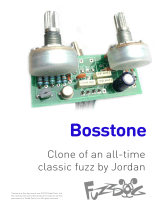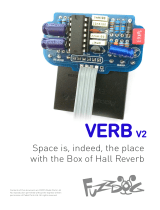Page is loading ...

Impossible Drive
How many inexplicable sounds
have you created today?
Contents of this document are ©2015 Pedal Parts Ltd.
No reproduction permitted without the express written
permission of Pedal Parts Ltd. All rights reserved.

Schematic!!!!??!?!!>>>>@%$
BOM
R1 3M3
R2 3M3
R3 3M3
R4 3M3
R5 10M
R6 3M3
R7 100K
R8 3M3
R9 3M3
R10 3M3
R11 1M
R12 3M3
R13 2M2
R14 220K
R15 3M3
R17 10K
C1 22n
C2 10n
C3 100n
C4 100n
C5 100n
C6 33n
C7 10n
C8 10n
C9 100n
C10 10n
C11 10n
C12 47n
C13 33n
C14 10n
Q1 2N3391A
Q2 2N2907A
Q3 2N2907A
Q4 2N2222
Q5 2N2907A
Q6 MPSA18
I100KB
II 1MB
III 500KB
III 500KB
INPUT 500KB
OUT 100KA
VOLTS* 50KB
T1* 47K Trim
SWITCHES SPDT ON-ON
*VOLTS control is entirely optional. This is a FuzzDog addition to the circuit giving a
wider range of sounds. Use EITHER the VOLTS pot, or trimmer T1 in conjunction
with a toggle switch in the VS postition. You can leave it out altogether. See notes
further into the document.

The power and signal pads on the PCB conform to the FuzzDog Direct Connection format, so can
be paired with the appropriate daughterboard for quick and easy offboard wiring. If you use a 6-way
connection cable you can choose to take your jack connections from the main PCB or the
daughterboard. It’s up to you. If you’re not using a daughterboard ignore the J-IN and J-OUT
connectors - they won’t attach to anything without the daughterboard.
Be very careful when soldering the LED and transistors. They’re very sensitive to heat. You should
use some kind of heat sink (crocodile clip or reverse action tweezers) on each leg as you solder
them. Keep exposure to heat to a minimum (under 2 seconds).
Snap the small metal tag off the pots so they can be mounted flush in the box.
Pots and toggle switches mount on the back side of the board. You can use vertical-mount pots or
just wire up ‘normal’ ones. It’s a good idea to place the pots in their holes in the enclosure when
you’re soldering them in place on the PCB. That way you know they’re going to line up ok. Best way
to do it is to solder a single pin of each pot in place, then do a visual check to see that they’re all
sitting at the same height. If not, melt the joints and readjust any that are off.
If your pots don’t have protective plastic
covers you should place a strip of thick card
between them and the board when
soldering to keep them a good distance
from the pcb to avoid shorting other
components.
You should solder all other board-mounted
components before you solder the pots.
Once they’re in place you’ll have no access
to much of the underside of the board.
The bottom of your board should look a bit
like this, depending on your VOLTS options.
PCB Layout ©2015 Pedal Parts Ltd.

Danger, Danger.... Low Voltage!
The optional VOLTS control is a voltage starve. This can do crazy things to a circuit, and is a lot of
fun to play with. If you’re into wild sounds, go for it.
You have three choices:
•External pot - full control of the voltage sag with a knob. Just fit the pot and you’re
good.
•Internal trimmer / external toggle - preset your sag amount and engage with switch.
For this just add T1 and the VS toggle switch. Adjust T1 until you get the effect you’re
after.
•None. Simply put a jumper between the top and middle pads of the VS switch as shown
on the previous page.
What does all that stuff do?
That schematic is a crazy mess, right? To be honest, most of the controls are so interactive
with each other that its hard to say. If you look at the schem you’ll see they’re altering bias
voltages, sending feedback and altering signal frequencies. The only really predictable
controls are:
•INPUT - just like your guitar volume.
•OUT - output volume.
•VOLTS - we know it’s a voltage starve, but like the other controls it’ll do completely
different things depending on how everything else is set.
Embrace the chaos or don’t bother building this.
I got the power....
The V pad at the top of the PCB is directly connected to the one at the bottom, and all the
GND pads are connected. If using a daughterboard its easiest to connect your DC socket
with the pads at the top. There’s no need to also connect the daughterboard V and G pads
to power.

Test the board!
UNDER NO CIRCUMSTANCES will troubleshooting help
be offered if you have skipped this stage. No exceptions.
Once you’ve finished the circuit it makes sense to test is before starting on
the switch and LED wiring. It’ll cut down troubleshooting time in the long
run. If the circuit works at this stage, but it doesn’t once you wire up the
switch - guess what? You’ve probably made a mistake with the switch.
Solder some nice, long lengths of wire to the board connections for 9V, GND,
IN and OUT. Connect IN and OUT to the jacks as shown. Connect all the
GNDs together (twist them up and add a small amount of solder to tack it).
Connect the battery + lead to the 9V wire, same method. Plug in. Go!
If it works, crack on and do your switch wiring. If not... aw man.
At least you know the problem is with the circuit. Find out why, get it
working, THEN worry about the switch etc.
UO
YRET
T
A
AT
B
NI
TU
GND
9V
IN
S
T
UDING WIRED PO
INCL
cuit boa
w cir
e, ne
our nic
Y
o
NI
OUT
!!!!
d
ar
TUO

(if using a daughterboard please refer to the relevant document)
Wire it up - DC only version
This circuit is standard, Negative GND. Your power supply should be
Tip Negative / Sleeve Positive. That’s the same as your standard pedals
(Boss etc), and you can safely daisy-chain your supply to this pedal.
The BOARD GND connections don’t all have to connect to one point.
They can be daisy-chained around the circuit, using larger connection
points (such as jack socket lugs) for multiple connections. As long as
they all connect together in some way.
L
E
D
BOARD
OUT
BOARD
9V
BOARD
GND
BOARD
GND
BOARD
GND
BOARD
INPUT
+
IN
OUT
L
E
D
BOARD
GND
BOARD
LED+

(if using a daughterboard please refer to the relevant document)
Wire it up - with battery
This circuit is standard, Negative GND. Your power supply should be
Tip Negative / Sleeve Positive. That’s the same as your standard pedals
(Boss etc), and you can safely daisy-chain your supply to this pedal.
The BOARD GND connections don’t all have to connect to one point.
They can be daisy-chained around the circuit, using larger connection
points (such as jack socket lugs) for multiple connections. As long as
they all connect together in some way.
PedalParts.co.uk
L
E
D
BOARD
OUT
BOARD
9V
BOARD
GND
BOARD
GND
BOARD
GND
BOARD
INPUT
BATTERY
+
IN
OUT
L
E
D
BOARD
GND
BOARD
LED+
+
Just because the
FuzzDog enclosure
won’t take a battery,
there’s nothing
stopping you using a
bigger box.

Drilling template
Hammond 1590BB
91 x 116 x 30mm
(top face dimensions, not including lid)
Recommended drill sizes:
Pots 7mm
Jacks 10mm
Footswitch 12mm
DC Socket 12mm
Toggle Switch 6mm
This template is a rough guide only. You should ensure correct marking of your
enclosure before drilling. You use this template at your own risk.
Pedal Parts Ltd can accept no responsibility for incorrect drilling of enclosures.
PedalParts.co.uk
30mm
15mm
15mm
30mm
7mm
It’s a good idea to drill the holes for the pots and toggles
1mm larger to give
yourself some
wiggle room
unless you’re a
drill ninja
/









